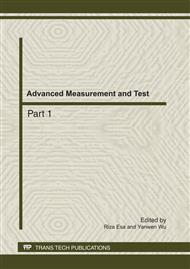p.1612
p.1618
p.1624
p.1629
p.1635
p.1639
p.1643
p.1648
p.1652
Design of High Precision Sunlight Intensity Measurement Device
Abstract:
Photoelectric detection technology is a kind of new technology of non-contact measure, and it is one of the most important means and methods of modern detection technology. The design of the high precision sunlight intensity measurement device is based on photoelectric detection technology. The sunlight intensity energy is received by the photodiode, and then it is transferred into electrical energy, the current. After the filtration and amplification, the current is converted into digital signal by the ICL7106 A/D converter. Ultimately, the accurate value is displayed on the LED digital tubes. The value shows the sunlight intensity at the moment of the measurement. The experimental result shows that the sunlight intensity is different at the different times.
Info:
Periodical:
Pages:
1635-1638
Citation:
Online since:
July 2011
Authors:
Keywords:
Price:
Сopyright:
© 2011 Trans Tech Publications Ltd. All Rights Reserved
Share:
Citation:


